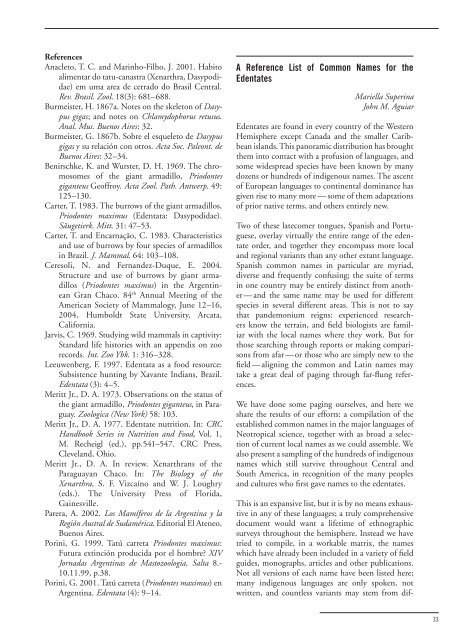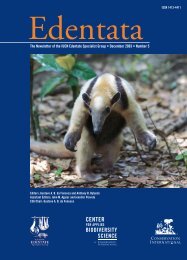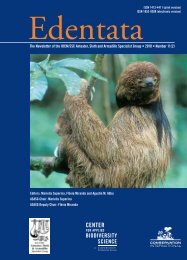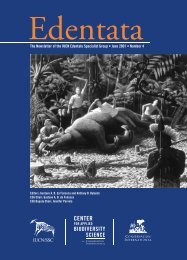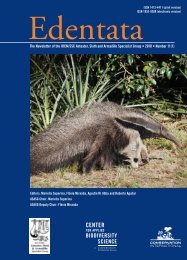Edentata 7 - Anteater, Sloth & Armadillo Specialist Group
Edentata 7 - Anteater, Sloth & Armadillo Specialist Group
Edentata 7 - Anteater, Sloth & Armadillo Specialist Group
- No tags were found...
Create successful ePaper yourself
Turn your PDF publications into a flip-book with our unique Google optimized e-Paper software.
References<br />
Anacleto, T. C. and Marinho-Filho, J. 2001. Habito<br />
alimentar do tatu-canastra (Xenarthra, Dasypodidae)<br />
em uma area de cerrado do Brasil Central.<br />
Rev. Brasil. Zool. 18(3): 681–688.<br />
Burmeister, H. 1867a. Notes on the skeleton of Dasypus<br />
gigas; and notes on Chlamydophorus retusus.<br />
Anal. Mus. Buenos Aires: 32.<br />
Burmeister, G. 1867b. Sobre el esqueleto de Dasypus<br />
gigas y su relación con otros. Acta Soc. Paleont. de<br />
Buenos Aires: 32–34.<br />
Benirschke, K. and Wurster, D. H. 1969. The chromosomes<br />
of the giant armadillo, Priodontes<br />
giganteus Geoffroy. Acta Zool. Path. Antwerp. 49:<br />
125–130.<br />
Carter, T. 1983. The burrows of the giant armadillos,<br />
Priodontes maximus (<strong>Edentata</strong>: Dasypodidae).<br />
Säugetierk. Mitt. 31: 47–53.<br />
Carter, T. and Encarnação, C. 1983. Characteristics<br />
and use of burrows by four species of armadillos<br />
in Brazil. J. Mammal. 64: 103–108.<br />
Ceresoli, N. and Fernandez-Duque, E. 2004.<br />
Structure and use of burrows by giant armadillos<br />
(Priodontes maximus) in the Argentinean<br />
Gran Chaco. 84 th Annual Meeting of the<br />
American Society of Mammalogy, June 12–16,<br />
2004, Humboldt State University, Arcata,<br />
California.<br />
Jarvis, C. 1969. Studying wild mammals in captivity:<br />
Standard life histories with an appendix on zoo<br />
records. Int. Zoo Ybk. 1: 316–328.<br />
Leeuwenberg, F. 1997. <strong>Edentata</strong> as a food resource:<br />
Subsistence hunting by Xavante Indians, Brazil.<br />
<strong>Edentata</strong> (3): 4–5.<br />
Meritt Jr., D. A. 1973. Observations on the status of<br />
the giant armadillo, Priodontes giganteus, in Paraguay.<br />
Zoologica (New York) 58: 103.<br />
Meritt Jr., D. A. 1977. Edentate nutrition. In: CRC<br />
Handbook Series in Nutrition and Food, Vol. 1,<br />
M. Recheigl (ed.), pp.541–547. CRC Press,<br />
Cleveland, Ohio.<br />
Meritt Jr., D. A. In review. Xenarthrans of the<br />
Paraguayan Chaco. In: The Biology of the<br />
Xenarthra, S. F. Vizcaíno and W. J. Loughry<br />
(eds.). The University Press of Florida,<br />
Gainesville.<br />
Parera, A. 2002. Los Mamíferos de la Argentina y la<br />
Región Austral de Sudamérica. Editorial El Ateneo,<br />
Buenos Aires.<br />
Porini, G. 1999. Tatú carreta Priodontes maximus:<br />
Futura extinción producida por el hombre XIV<br />
Jornadas Argentinas de Mastozoologia, Salta 8.-<br />
10.11.99, p.38.<br />
Porini, G. 2001. Tatú carreta (Priodontes maximus) en<br />
Argentina. <strong>Edentata</strong> (4): 9–14.<br />
A Reference List of Common Names for the<br />
Edentates<br />
Mariella Superina<br />
John M. Aguiar<br />
Edentates are found in every country of the Western<br />
Hemisphere except Canada and the smaller Caribbean<br />
islands. This panoramic distribution has brought<br />
them into contact with a profusion of languages, and<br />
some widespread species have been known by many<br />
dozens or hundreds of indigenous names. The ascent<br />
of European languages to continental dominance has<br />
given rise to many more — some of them adaptations<br />
of prior native terms, and others entirely new.<br />
Two of these latecomer tongues, Spanish and Portuguese,<br />
overlay virtually the entire range of the edentate<br />
order, and together they encompass more local<br />
and regional variants than any other extant language.<br />
Spanish common names in particular are myriad,<br />
diverse and frequently confusing; the suite of terms<br />
in one country may be entirely distinct from another<br />
— and the same name may be used for different<br />
species in several different areas. This is not to say<br />
that pandemonium reigns: experienced researchers<br />
know the terrain, and field biologists are familiar<br />
with the local names where they work. But for<br />
those searching through reports or making comparisons<br />
from afar — or those who are simply new to the<br />
field — aligning the common and Latin names may<br />
take a great deal of paging through far-flung references.<br />
We have done some paging ourselves, and here we<br />
share the results of our efforts: a compilation of the<br />
established common names in the major languages of<br />
Neotropical science, together with as broad a selection<br />
of current local names as we could assemble. We<br />
also present a sampling of the hundreds of indigenous<br />
names which still survive throughout Central and<br />
South America, in recognition of the many peoples<br />
and cultures who first gave names to the edentates.<br />
This is an expansive list, but it is by no means exhaustive<br />
in any of these languages; a truly comprehensive<br />
document would want a lifetime of ethnographic<br />
surveys throughout the hemisphere. Instead we have<br />
tried to compile, in a workable matrix, the names<br />
which have already been included in a variety of field<br />
guides, monographs, articles and other publications.<br />
Not all versions of each name have been listed here;<br />
many indigenous languages are only spoken, not<br />
written, and countless variants may stem from dif-<br />
33


